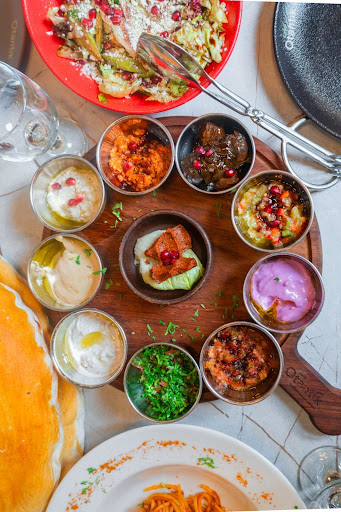Have you ever tasted a dessert that feels like a journey through history and culture? Mediterranean sweets do exactly that. They carry flavors from the coasts of Turkey, the heart of the Middle East, and the sunlit shores of Southern Europe.
This blog explores seven beloved Mediterranean desserts that delight anyone with a sweet tooth. We will discover their origins, textures, and the magic behind their flavors. Whether you are in Dubai searching for a late-night treat or simply curious about global desserts, these classics deserve a spot on your plate.
1. Kunafa: The Golden Classic
Kunafa is a showstopper of Middle Eastern sweets. Shredded phyllo dough is filled with sweet cheese or thick cream, baked until crisp and golden, then drenched in fragrant sugar syrup. The result is a dessert that crackles on the outside and melts inside.
Its roots stretch back centuries across the Levant and Egypt, where families pass recipes down like treasures. The balance of crunchy pastry and soft, gooey filling makes it a treat for all senses. Served warm, kunafa pairs beautifully with strong coffee or a glass of mint tea.
2. Traliche Cake: A Mediterranean Take on Tres Leches
This light sponge cake carries a surprising story. Inspired by the Latin American tres leches, traliche blends global influence with Mediterranean flair. The sponge is soaked in three types of milk—evaporated, condensed, and fresh—then finished with a smooth caramel glaze.
The cake absorbs the milk until every bite is creamy but never heavy. Its subtle sweetness and soft texture make it perfect after a rich meal. In Dubai, cafés and Mediterranean spots often feature this dessert as a nod to both tradition and creative adaptation.
3. Cheesecake: Smooth, Creamy, Timeless
Cheesecake might sound international, but it has deep Mediterranean roots dating back to ancient Greece. Today it remains a beloved dessert from New York to Istanbul. The version found across Mediterranean cafés is simple yet indulgent: a rich cheese filling on a crisp biscuit crust.
Whether served plain or topped with fruit or chocolate, cheesecake provides a creamy counterpoint to strong coffee. Its gentle sweetness makes it a favorite for those who prefer a dessert that satisfies without overwhelming.
4. Baklava: Layers of History and Honey
Baklava is a masterpiece of delicate craftsmanship. Thin sheets of phyllo pastry are stacked with crushed nuts—often pistachios or walnuts—then baked and soaked in a fragrant sugar or honey syrup. Each bite offers a flaky crunch followed by a gentle sweetness.
Legends claim it originated in the imperial kitchens of the Ottoman Empire, though many cultures proudly claim it. Baklava reflects the essence of Mediterranean hospitality: rich, inviting, and meant to be shared with friends over tea or coffee.
5. Baklava with Ice Cream: A Modern Twist
Sometimes tradition invites innovation. Warm baklava served with a scoop of vanilla ice cream adds a delightful contrast of hot and cold. The crisp pastry softens slightly under the melting ice cream, creating a creamy, nutty bite that feels both familiar and exciting.
This version highlights how Mediterranean desserts adapt to modern palates. It is the perfect choice when you crave a classic with a playful edge.
6. Kazandibi: Turkish Caramel Dream
Kazandibi is a Turkish milk pudding with a caramelized base. Its name means “bottom of the pan,” a tribute to the golden crust formed during cooking. Soft, creamy, and lightly sweet, it offers comfort in every spoonful.
This dessert showcases the Turkish love of milk-based sweets and gentle flavors. It is less sugary than many desserts, making it ideal for those who want a mellow, satisfying finish to a meal.
7. Rice Pudding: Comfort in a Bowl
Rice pudding may sound simple, but its Mediterranean version sings with subtlety. Slow-cooked rice blends with milk and sugar, infused with vanilla or rose water for a fragrant touch. Served warm or chilled, it carries the warmth of home cooking.
Many cultures have their own take on rice pudding, but Mediterranean recipes focus on creamy texture and delicate floral notes. It is the dessert you turn to when you crave nostalgia and quiet comfort.
Other Sweet Companions
Mediterranean dessert menus often feature brownies and tiramisu as well, reflecting the region’s openness to global influences. A rich chocolate brownie can follow a plate of mezze just as happily as a slice of cheesecake, while tiramisu brings Italian coffee flavors to the table.
Tips to Savor Mediterranean Desserts
Pair with the Right Drink
Rich Mediterranean desserts shine when paired with the right beverage. Strong Turkish coffee adds a deep, slightly bitter contrast, while mint tea offers a refreshing herbal note. Both balance the sweetness, making every bite feel layered, satisfying, and complete.
Share the Plate
Many Mediterranean sweets are dense and rich, making them perfect for sharing. Split a serving of kunafa or baklava with friends so everyone can taste more options. Sharing creates conversation, reduces heaviness, and turns dessert into a fun social ritual.
Enjoy Slowly
These desserts reward patience. Take small bites to appreciate each texture—the crunch of phyllo, the creaminess of pudding, the syrup’s fragrant sweetness. Eating slowly lets flavors bloom and makes a simple dessert moment feel indulgent and memorable.
Mix Warm and Cold
For a playful contrast, pair a warm dessert like kunafa or baklava with a scoop of cool ice cream. The heat melts the cold cream slightly, blending temperatures and textures into a single, surprising, and delightful mouthful.
Ask About Origins
Mediterranean desserts carry centuries of history. Ask the staff where a recipe comes from or how it is traditionally served. Learning these stories deepens appreciation, turning dessert from just a sweet treat into a cultural and flavorful journey worth remembering.
Final Bite
Mediterranean desserts celebrate tradition and creativity. From the golden crunch of kunafa to the creamy comfort of rice pudding, each sweet offers a unique taste of culture and history. Whether you find them in a bustling Dubai café or on a quiet evening at home, these desserts turn simple moments into memorable ones.
Frequently Asked Questions
What drink pairs best with Mediterranean desserts?
Strong Turkish coffee or mint tea highlights the flavors of rich desserts like baklava or kunafa. The slight bitterness balances the sweetness, while herbal notes from mint tea refresh the palate after creamy or syrupy bites.
Are Mediterranean desserts always very sweet?
Not all of them. Desserts like kazandibi or rice pudding are gently sweet, focusing more on creamy texture and subtle flavors. Others, such as baklava, use syrup for a bolder sweetness, giving you options based on your personal preference and mood.
Can Mediterranean desserts be enjoyed cold?
Yes, many are delicious when chilled. Rice pudding and traliche cake taste refreshing straight from the fridge, while cheesecake is usually served cool. Chilled servings can highlight floral or citrus notes often used in Mediterranean recipes.
Are these desserts suitable for sharing?
Absolutely. Mediterranean dining often centers on hospitality and community. Desserts like kunafa or baklava are typically cut into portions for the table, encouraging guests to share, taste different items, and enjoy a social dessert experience together.
Do these desserts contain common allergens?
Several include ingredients like nuts, dairy, or gluten. Baklava contains nuts and wheat phyllo pastry, cheesecake uses dairy, and rice pudding contains milk. If you have allergies, always ask about specific ingredients before ordering or sampling any dessert.







